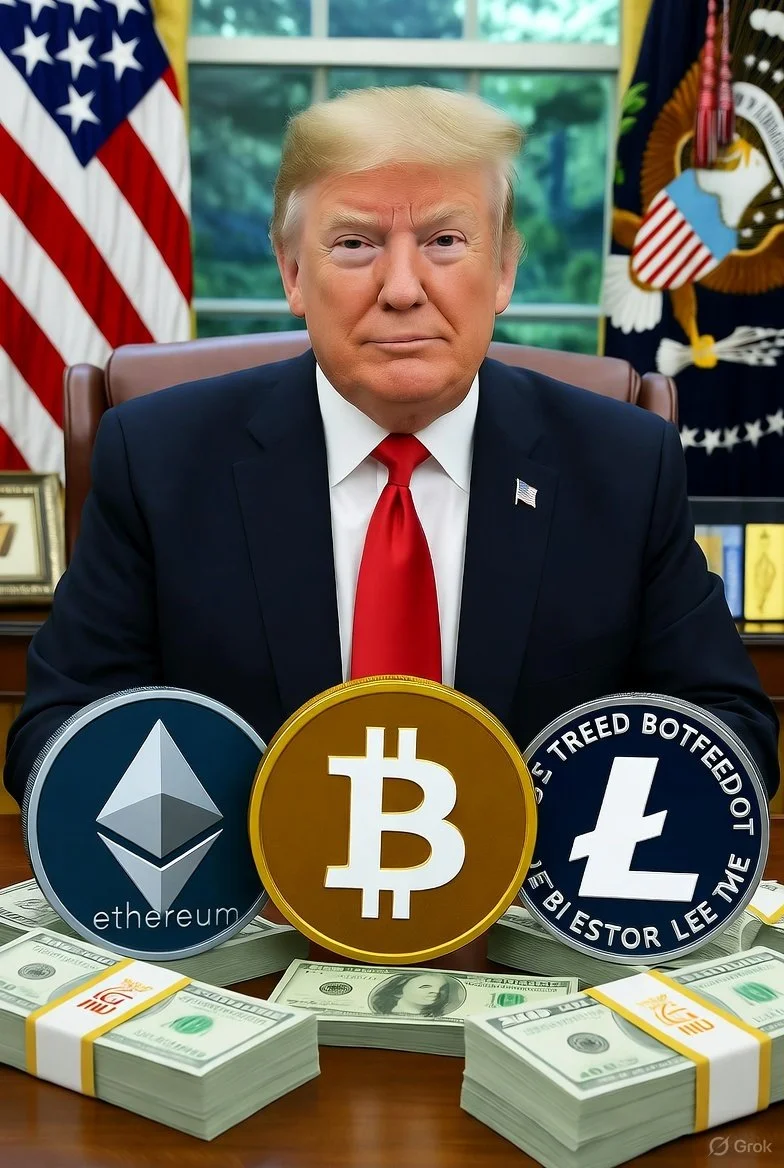Trump’s Crypto Madness
In the crisp dawn of October 2025, Bitcoin shattered records, soaring past $125,000 amid a frenzy that propelled the entire cryptocurrency market capitalization to over $4 trillion, even as minor dips hinted at underlying volatility.
Ethereum and other digital coins followed suit, with analysts attributing the surge to renewed spot demand, massive inflows into exchange-traded funds, and the historical bullish patterns of October, where Bitcoin has averaged 20.75% gains since 2015.
Bitcoin’s volatility and periodic bullish surges, which often occur independently of broader markets, follow recurring “cycles” roughly every four years. These patterns stem from Bitcoin’s own technological design and the nature of a market composed largely of fictitious capital.
Yet, beneath this glittering ascent lies a more sinister narrative: the Trump administration’s so-called “crypto revolution,” a policy blitz that promises to crown America as the “crypto capital of the world” but risks inflating a colossal bubble at the expense of the working masses.
President Donald J. Trump, once a vocal skeptic of digital currencies, has pivoted with imperial zeal, signing a cascade of executive orders and legislation to embed cryptocurrency into the fabric of U.S. economic dominance. In January 2025, mere days into his second term, Trump issued an executive order championing digital assets as pivotal to innovation, directing federal agencies to foster blockchain across sectors while repealing restrictive measures like SAB 121.
By March, he established the Strategic Bitcoin Reserve and U.S. Digital Asset Stockpile, amassing seized cryptocurrencies into a national hoard valued in the billions, positioning the government as a major player in the market.
Culminating in July with the GENIUS Act—the first major federal law regulating stablecoins—Trump’s agenda has unleashed a torrent of deregulation, neutralizing warnings from prior administrations and inviting speculative capital to flood in.
Cryptocurrencies and blockchain technology have become key features of modern capitalism, enabling near-instant fund transfers compared to traditional banking delays. Bitcoin’s original aim was to create a transparent digital currency functioning outside established financial institutions. However, what we observe is its increasing integration into traditional finance (TradFi).
Proponents hail this as a bold stride toward financial sovereignty, but in truth, it exemplifies capitalist corruption at its core: a scheme to lead not innovation, but engineered bubbles that serve bourgeois interests while exploiting the proletariat.
Experts across the spectrum decry this haste as reckless, emphasizing the intricate web of risks woven into the digital market. National security specialists warn that lax crypto policies could exacerbate money laundering, sanctions evasion, and cyber threats, urging lawmakers to fortify regulations rather than dismantle them.
Brookings Institution analysts highlight potential harms ranging from financial instability and investor fraud to environmental degradation and public safety perils, advocating for principles of fairness and accountability to shield ordinary Americans from predatory practices.
Even within the industry, voices like those from Atlantic Council experts question the erosion of privacy and the specter of government overreach in daily transactions, arguing that Trump’s pro-crypto stance lacks the thorough deliberation needed to mitigate systemic dangers.
No “instant crypto capital” proclamation can obscure the truth: this is not progress, but a perilous gamble with the livelihoods of millions, where hasty actions invite catastrophe under the guise of economic liberation.
At the heart of Trump’s proactive crypto embrace lies a more insidious motive, one that reeks of imperialist maneuvering to offload America’s staggering $37 trillion national debt onto the global proletariat. During his 2024 campaign, Trump floated the audacious idea of using Bitcoin to erase the debt pile, a notion that has morphed into policy through the Strategic Reserve.
Critics speculate—and with good reason—that the administration envisions inflating the market by purchasing vast quantities of high-profile assets like Bitcoin and Ethereum, driving prices “to the moon” through state-backed demand, only to liquidate at peak valuations for trillions in profit to service the debt.
This pump-and-dump on a sovereign scale would devalue the debt by transferring its burden to unwitting investors worldwide. But the fallout? A market plunge into the abyss, vaporizing savings for businesses and individuals alike. Millions of Americans, lured by the administration’s hype into crypto holdings, would find their retirements and nest eggs obliterated—a direct betrayal of the “America First” mantra bellowed at every rally. Is this America First to be fleeced? The hypocrisy is stark: a bourgeois elite ready to rob their own working class in the name of fiscal salvation.
At the same time, crypto carries an ideological allure—especially for younger generations—suggesting an escape from wage labor through speculation. Yet it ultimately reaffirms a core principle of political economy: exchange alone cannot create value. The gains of some come at the expense of others. Integrated into global finance, the crypto market reveals the domination of monopolies and that the true substance of value remains human labor power.
The international repercussions could be apocalyptic, igniting global discontent and even conflict. Allies and adversaries invested in U.S.-backed crypto ecosystems would view this as economic warfare, a unilateral deprivation of wealth that shatters trust in American hegemony.
Nations like those in Europe or Asia, with substantial stakes in digital assets, might retaliate through trade wars, sanctions, or worse—escalating tensions into outright hostilities. In a world already frayed by imperialist rivalries, such a maneuver could unite the global proletariat against U.S. exploitation, fostering alliances of resistance that no amount of military posturing could quell. Who would emerge satisfied from this chaos? Certainly not the masses, left destitute in the ruins of a manufactured crisis.
Compounding this madness is the Trump family’s intimate entanglement with the crypto realm, a glaring conduit for personal enrichment masquerading as entrepreneurial flair. In late August 2025, Trump’s sons—Eric, Donald Jr., and Barron—launched World Liberty Financial (WLFI), a DeFi platform with its own governance token, amid fanfare tied to the president’s pro-crypto rhetoric.
The token debuted at around 40 cents, only to crater by 41% to 48% within hours or days, dipping as low as 21 cents before partial recovery—a classic pump-and-dump where early hype draws in buyers, allowing insiders to offload holdings for profit.
Despite the volatility, the family’s locked stake of 22.5 billion tokens ballooned to a $5 billion paper fortune, underscoring conflicts of interest that ethicists decry as a “roadmap for corruption.”
White House officials with crypto ties further blur lines, raising alarms that policy serves familial gain over public good.
This is no coincidence; it’s the logical rot of a system where monopoly capital and political power converge to extract from the masses.
In summation, Trump’s audacious bid to dominate the crypto frontier masks two deranged objectives: amassing windfall profits to unburden America’s debt and lining bourgeois pockets, including his own kin’s. The cause—fiscal relief—may appear noble in isolation, yet the methodology is not merely flawed but catastrophic, poised to unleash widespread discontent, proletarian ruin, and potentially global war. This capitalist folly demands vigilance; the working class must awaken to these machinations, rejecting the facade of digital empowerment by fighting for socialism before the bubble bursts and engulfs us all in its imperial debris.

